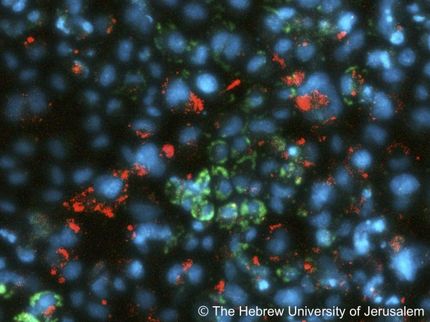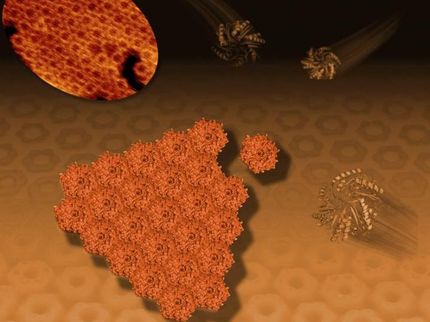New microscopy technique offers close-up, real-time view of cellular phenomena
MIT scientists record first microscopic images showing deadly effects of AMPs
For two decades, scientists have been pursuing a potential new way to treat bacterial infections, using naturally occurring proteins known as antimicrobial peptides (AMPs). Now, MIT scientists have recorded the first microscopic images showing the deadly effects of AMPs, most of which kill by poking holes in bacterial cell membranes.
Researchers in the laboratory of MIT Professor Angela Belcher modified an existing, extremely sensitive technique known as high-speed atomic force microscopy (AFM) to allow them to image the bacteria in real time. Their method, described in Nature Nanotechnology , represents the first way to study living cells using high-resolution images recorded in rapid succession.
Using this type of high-speed AFM could allow scientists to study how cells respond to other drugs and to viral infection, says Belcher, the Germeshausen Professor of Materials Science and Engineering and Biological Engineering. The new work could also help researchers understand how some bacteria can become resistant to AMPs (none of which have been approved as drugs yet).
In recent years, scientists have developed high-speed AFM techniques, but haven't optimized them for living cells. That's what the MIT team set out to do, building on the experience of lead author Georg Fantner, a postdoctoral associate in Belcher's lab who had worked on high-speed AFM at the University of California at Santa Barbara.
Atomic force microscopy makes use of a cantilever equipped with a probe tip that "feels" the surface of a sample. Forces between the tip and the sample can be measured as the probe moves across the sample, revealing the shape of the surface. The MIT team used a cantilever about 1,000 times smaller than those normally used for AFM, which enabled them to increase the imaging speed without harming the bacteria.
With the new setup, the team was able to take images every 13 seconds over a period of several minutes. They found that AMP-induced cell death appears to be a two-step process: a short incubation period followed by a rapid "execution." They were surprised to see that the onset of the incubation period varied from 13 to 80 seconds.
"Not all of the cells started dying at the exact same time, even though they were genetically identical and were exposed to the peptide at the same time," says Roberto Barbero, a graduate student in biological engineering and an author of the paper.
Next steps: In the future, Belcher hopes to use atomic force microscopy to study other cellular phenomena, including the assembly of viruses in infected cells, and the effects of traditional antibiotics on bacterial cells. The technique may also prove useful in studying mammalian cells.
Original publication: Georg Fantner, Roberto Barbero, David Gray and Angela Belcher; "Kinetics of antimicrobial peptide activity measured on individual bacterial cells using high-speed atomic force microscopy"; Nature Nanotechology 2010.
Most read news
Other news from the department science
These products might interest you

Kjel- / Dist Line by Büchi
Kjel- and Dist Line - steam distillation and Kjeldahl applications
Maximum accuracy and performance for your steam distillation and Kjeldahl applications

AZURA Purifier + LH 2.1 by KNAUER
Preparative Liquid Chromatography - New platform for more throughput
Save time and improve reproducibility during purification

Get the analytics and lab tech industry in your inbox
By submitting this form you agree that LUMITOS AG will send you the newsletter(s) selected above by email. Your data will not be passed on to third parties. Your data will be stored and processed in accordance with our data protection regulations. LUMITOS may contact you by email for the purpose of advertising or market and opinion surveys. You can revoke your consent at any time without giving reasons to LUMITOS AG, Ernst-Augustin-Str. 2, 12489 Berlin, Germany or by e-mail at revoke@lumitos.com with effect for the future. In addition, each email contains a link to unsubscribe from the corresponding newsletter.
























































